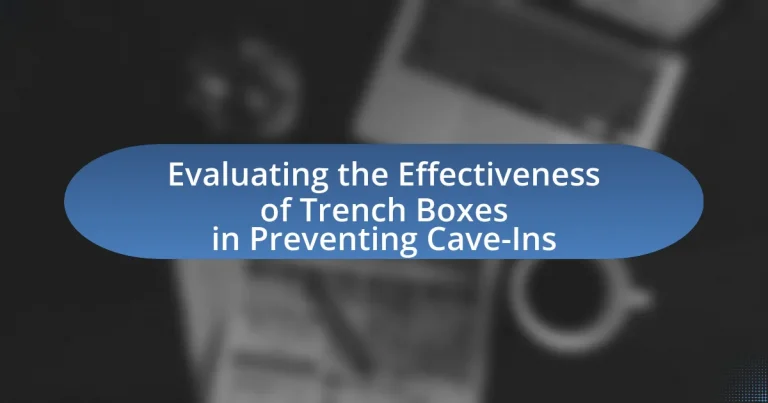Trench boxes, also known as trench shields, are essential protective structures used in construction to prevent cave-ins during excavation work, thereby safeguarding workers from serious injuries or fatalities. This article evaluates the effectiveness of trench boxes in preventing cave-ins, discussing their design, materials, and compliance with Occupational Safety and Health Administration (OSHA) regulations. It highlights the critical role of proper installation, soil assessment, and regular inspections in ensuring safety, as well as the impact of cave-ins on worker safety and project timelines. Additionally, the article addresses the challenges and best practices associated with the use of trench boxes in various soil conditions and weather scenarios.

What are Trench Boxes and Their Purpose in Construction?
Trench boxes are protective structures used in construction to safeguard workers in excavated areas. Their primary purpose is to prevent cave-ins during trenching operations, which can be hazardous and lead to serious injuries or fatalities. Trench boxes, also known as trench shields, are designed to support the walls of the excavation, allowing workers to operate safely within the trench. According to the Occupational Safety and Health Administration (OSHA), proper use of trench boxes can significantly reduce the risk of cave-ins, which are responsible for a substantial number of construction-related accidents.
How do Trench Boxes function to prevent cave-ins?
Trench boxes function by providing a protective barrier that supports the walls of an excavation, thereby preventing cave-ins. These boxes are typically made of steel or aluminum and are designed to withstand the lateral pressure exerted by the surrounding soil. When installed correctly, trench boxes create a safe working environment by allowing workers to operate within the excavation without the risk of soil collapse. According to the Occupational Safety and Health Administration (OSHA), using trench boxes can significantly reduce the likelihood of accidents related to cave-ins, which are among the leading causes of fatalities in excavation work.
What materials are commonly used in the construction of Trench Boxes?
Trench boxes are commonly constructed using steel, aluminum, and composite materials. Steel is favored for its strength and durability, making it suitable for heavy-duty applications. Aluminum is lighter and offers corrosion resistance, which is beneficial for ease of transport and use in various environments. Composite materials, while less common, provide a lightweight alternative with good strength-to-weight ratios. These materials are selected based on their ability to withstand the pressures of surrounding soil and prevent cave-ins, ensuring worker safety during excavation activities.
How do the design features of Trench Boxes enhance safety?
Trench boxes enhance safety through their structural design, which includes reinforced walls and a stable base that prevent soil collapse during excavation. These features are specifically engineered to withstand lateral earth pressures, significantly reducing the risk of cave-ins, which are a leading cause of fatalities in trenching operations. According to OSHA regulations, trench boxes must meet specific standards to ensure worker safety, demonstrating their effectiveness in providing a protective barrier against potential hazards.
Why is cave-in prevention critical in excavation work?
Cave-in prevention is critical in excavation work because it directly safeguards the lives of workers and prevents significant injuries or fatalities. According to the Occupational Safety and Health Administration (OSHA), cave-ins are among the most dangerous hazards in excavation, with the potential to cause serious harm or death to individuals trapped under collapsing soil. Statistics indicate that approximately 1 in 10 excavation-related fatalities results from cave-ins, highlighting the urgent need for effective prevention measures. Implementing proper safety protocols, such as the use of trench boxes, can significantly reduce the risk of cave-ins and enhance overall site safety.
What are the statistics related to cave-ins in construction sites?
Cave-ins at construction sites are a significant safety concern, with statistics indicating that they account for approximately 25% of all excavation-related fatalities. According to the Occupational Safety and Health Administration (OSHA), from 2011 to 2018, there were 1,000 reported incidents of trench collapses, resulting in 300 fatalities. Furthermore, the National Institute for Occupational Safety and Health (NIOSH) reports that the risk of a fatality increases dramatically when workers are buried under more than five cubic yards of soil. These statistics underscore the critical need for effective safety measures, such as trench boxes, to prevent cave-ins and protect workers on construction sites.
How do cave-ins impact worker safety and project timelines?
Cave-ins significantly jeopardize worker safety and disrupt project timelines. When a cave-in occurs, workers can face severe injuries or fatalities, as statistics indicate that trench-related incidents account for approximately 20% of construction fatalities, highlighting the critical nature of safety measures. Additionally, cave-ins can lead to project delays, as recovery efforts and safety inspections can halt work for days or even weeks, ultimately increasing labor costs and extending project completion dates. The implementation of trench boxes has been shown to mitigate these risks, thereby enhancing worker safety and maintaining project schedules.

What are the Standards and Regulations Governing Trench Box Use?
The standards and regulations governing trench box use are primarily outlined by the Occupational Safety and Health Administration (OSHA) in the United States, specifically in 29 CFR 1926.652. These regulations require that trench boxes, also known as trench shields, be used to protect workers from cave-ins in trenches that are five feet deep or more. OSHA mandates that trench boxes must be designed to withstand the forces exerted by the surrounding soil, ensuring worker safety during excavation activities. Compliance with these standards is critical, as cave-ins can lead to serious injuries or fatalities; in fact, OSHA reports that trenching and excavation incidents account for a significant percentage of construction-related deaths.
What OSHA regulations apply to Trench Boxes?
OSHA regulations that apply to trench boxes are primarily found in 29 CFR 1926 Subpart P, which governs excavation and trenching operations. These regulations specify the requirements for protective systems, including trench boxes, to prevent cave-ins during excavation work. Specifically, OSHA mandates that when employees are working in trenches deeper than five feet, a protective system must be in place unless the excavation is made entirely in stable rock. The regulations also outline the design and installation criteria for trench boxes to ensure they can adequately support the surrounding soil and protect workers from potential hazards.
How do these regulations ensure worker safety?
Regulations ensure worker safety by mandating the use of trench boxes, which provide structural support to prevent cave-ins during excavation work. These regulations require that trenches deeper than five feet be protected with appropriate safety measures, such as trench boxes, to minimize the risk of soil collapse. According to the Occupational Safety and Health Administration (OSHA), cave-ins are among the leading causes of fatalities in excavation work, highlighting the critical need for such regulations to protect workers.
What are the penalties for non-compliance with these regulations?
Penalties for non-compliance with regulations regarding trench safety can include significant fines, legal action, and increased liability for injuries or fatalities. For instance, the Occupational Safety and Health Administration (OSHA) can impose fines that range from thousands to tens of thousands of dollars per violation, depending on the severity and nature of the infraction. Additionally, companies may face civil lawsuits from injured workers or their families, which can result in substantial financial compensation claims. These penalties serve to enforce compliance and ensure the safety of workers in trenching operations, highlighting the critical importance of adhering to established safety regulations.
How do industry standards influence the design of Trench Boxes?
Industry standards significantly influence the design of trench boxes by establishing safety requirements and performance criteria that ensure worker protection during excavation activities. These standards, such as those set by the Occupational Safety and Health Administration (OSHA) and the American National Standards Institute (ANSI), dictate the materials, dimensions, and structural integrity necessary for trench boxes to effectively prevent cave-ins. For instance, OSHA mandates that trench boxes must be capable of withstanding the lateral earth pressures exerted by the surrounding soil, which informs the engineering specifications and design calculations used by manufacturers. Compliance with these standards not only enhances the safety of workers but also minimizes the risk of legal liabilities for construction companies, thereby reinforcing the importance of adhering to established guidelines in the design process.
What organizations set these industry standards?
Organizations that set industry standards for trench boxes and cave-in prevention include the Occupational Safety and Health Administration (OSHA) and the American National Standards Institute (ANSI). OSHA establishes regulations that ensure safety in excavation and trenching operations, while ANSI develops consensus standards that guide best practices in construction safety. These organizations provide frameworks that help mitigate risks associated with trench collapses, thereby enhancing worker safety in the industry.
How often are these standards updated to reflect new safety data?
Standards related to trench safety, including the use of trench boxes, are typically updated every five years to reflect new safety data. This regular review cycle allows for the incorporation of the latest research findings, accident reports, and technological advancements into safety regulations. For instance, the Occupational Safety and Health Administration (OSHA) periodically revises its standards based on emerging evidence and industry practices, ensuring that safety measures remain effective and relevant.

What Factors Influence the Effectiveness of Trench Boxes?
The effectiveness of trench boxes is influenced by several key factors, including soil type, depth of excavation, and proper installation. Soil type affects the stability and pressure exerted on the trench box; for instance, cohesive soils provide better support than granular soils. The depth of excavation is critical, as deeper trenches require more robust support systems to prevent cave-ins. Proper installation, including ensuring that the trench box is correctly positioned and secured, is essential for maximizing its protective capabilities. According to OSHA regulations, trench boxes must be designed to withstand the lateral forces exerted by the surrounding soil, which varies based on these factors.
How does soil type affect the performance of Trench Boxes?
Soil type significantly affects the performance of trench boxes by influencing their stability and the risk of cave-ins. Cohesive soils, such as clay, provide better support for trench boxes due to their ability to hold shape and resist collapse, while granular soils, like sand, can lead to increased pressure on the trench box walls, raising the likelihood of failure. Studies indicate that trench boxes are most effective in cohesive soils, where the risk of cave-ins is lower, as opposed to loose or saturated granular soils, which can compromise the integrity of the trench box and increase safety hazards.
What are the different soil classifications and their implications?
Soil classifications include granular soils, cohesive soils, and organic soils, each with distinct implications for construction and excavation safety. Granular soils, such as sand and gravel, have high drainage capacity and low cohesion, making them less prone to cave-ins but requiring proper shoring techniques. Cohesive soils, like clay, exhibit high cohesion and can retain water, increasing the risk of cave-ins when saturated; thus, they necessitate more robust support systems. Organic soils, which contain decomposed plant material, are generally weak and compressible, posing significant challenges for stability and requiring careful assessment before excavation. Understanding these classifications is crucial for implementing effective trench boxes to prevent cave-ins, as each soil type demands specific engineering solutions to ensure worker safety.
How can soil conditions be assessed before trenching?
Soil conditions can be assessed before trenching through methods such as soil sampling, visual inspection, and geotechnical testing. Soil sampling involves collecting soil from various depths and locations to analyze its composition, moisture content, and density, which are critical for understanding stability. Visual inspection allows for the identification of surface conditions, such as vegetation and drainage patterns, which can indicate soil type and potential issues. Geotechnical testing, including standard penetration tests and cone penetration tests, provides quantitative data on soil strength and behavior under load, confirming the suitability of the soil for trenching activities. These assessment methods are essential for ensuring safety and preventing cave-ins during excavation.
What role does proper installation play in the effectiveness of Trench Boxes?
Proper installation is crucial for the effectiveness of trench boxes in preventing cave-ins. When trench boxes are installed correctly, they provide essential support to the walls of the excavation, significantly reducing the risk of soil collapse. According to OSHA regulations, proper installation involves ensuring that the trench box is appropriately sized for the excavation depth and that it is positioned correctly to distribute the load evenly. This adherence to guidelines is vital, as improper installation can lead to structural failure, resulting in serious injuries or fatalities. Therefore, the role of proper installation directly correlates with the safety and effectiveness of trench boxes in excavation sites.
What are the best practices for installing Trench Boxes?
The best practices for installing trench boxes include ensuring proper site assessment, selecting the appropriate size and type of trench box, and following manufacturer guidelines for installation. Conducting a thorough site assessment helps identify soil conditions and potential hazards, which is crucial for selecting the right trench box that meets safety standards. Adhering to manufacturer guidelines ensures that the trench box is installed correctly, maximizing its effectiveness in preventing cave-ins. Additionally, regular inspections during installation and use are essential to maintain safety and compliance with OSHA regulations, which state that trench boxes must be used in accordance with specific safety protocols to protect workers from cave-ins.
How can improper installation lead to failures?
Improper installation of trench boxes can lead to failures by compromising their structural integrity and effectiveness in preventing cave-ins. When trench boxes are not installed according to manufacturer specifications or industry standards, they may not provide adequate support for the surrounding soil, increasing the risk of collapse. For instance, a study by the Occupational Safety and Health Administration (OSHA) indicates that improper installation is a leading cause of trench-related accidents, with cave-ins occurring in improperly supported trenches. This highlights the critical importance of following proper installation procedures to ensure safety and prevent failures.
What are the common challenges faced when using Trench Boxes?
Common challenges faced when using trench boxes include improper installation, inadequate soil assessment, and limited space for equipment maneuvering. Improper installation can lead to insufficient support, increasing the risk of cave-ins, while inadequate soil assessment may result in using the wrong type of trench box for specific soil conditions, compromising safety. Additionally, limited space for equipment can hinder the effectiveness of trench boxes, making it difficult to maintain safe working conditions. These challenges highlight the importance of proper training and adherence to safety regulations in trench box usage.
How can weather conditions impact the use of Trench Boxes?
Weather conditions can significantly impact the use of trench boxes by affecting soil stability and worker safety. For instance, heavy rainfall can lead to saturated soil, increasing the risk of cave-ins, which trench boxes are designed to prevent. Additionally, extreme temperatures can cause soil to expand or contract, potentially compromising the structural integrity of the trench box. According to the Occupational Safety and Health Administration (OSHA), proper assessment of weather conditions is crucial for ensuring the effectiveness of trench boxes in preventing accidents during excavation work.
What are the logistical challenges in transporting and setting up Trench Boxes?
Transporting and setting up trench boxes involves several logistical challenges, including weight, size, and site accessibility. Trench boxes are typically heavy and bulky, requiring specialized equipment for transportation, which can complicate logistics, especially in urban areas with limited space. Additionally, the setup process demands careful planning to ensure that the boxes are positioned correctly and securely, which can be hindered by uneven terrain or existing infrastructure. Furthermore, coordinating the timing of delivery and installation with other construction activities is essential to avoid delays, making project management more complex. These factors collectively contribute to the logistical difficulties associated with trench box operations.
What are the best practices for ensuring the effectiveness of Trench Boxes?
The best practices for ensuring the effectiveness of trench boxes include proper installation, regular inspections, and adherence to safety regulations. Proper installation involves ensuring that the trench box is correctly sized for the excavation and that it is placed at the appropriate depth to provide maximum protection against cave-ins. Regular inspections should be conducted to check for any signs of damage or shifting, as well as to ensure that the trench box remains in compliance with OSHA standards, which mandate that trench boxes must be used in excavations deeper than five feet. Adhering to safety regulations, such as those outlined in the OSHA 1926 Subpart P, ensures that workers are protected and that the trench box functions effectively in preventing cave-ins.
How can regular inspections improve safety and effectiveness?
Regular inspections enhance safety and effectiveness by identifying potential hazards and ensuring compliance with safety standards. These inspections allow for the early detection of issues such as structural weaknesses in trench boxes, which can prevent cave-ins. According to the Occupational Safety and Health Administration (OSHA), regular inspections are critical in maintaining safe work environments, as they help to mitigate risks and ensure that safety equipment is functioning properly. By systematically evaluating the condition of trench boxes and other safety measures, organizations can significantly reduce the likelihood of accidents and improve overall operational efficiency.
What training is necessary for workers to use Trench Boxes safely?
Workers must undergo specific training that includes understanding trench safety regulations, proper installation and use of trench boxes, and recognizing hazards associated with trenching operations. This training is essential to ensure compliance with OSHA standards, which mandate that workers receive instruction on the safe use of protective systems like trench boxes to prevent cave-ins. Additionally, practical training on the correct setup and inspection of trench boxes enhances workers’ ability to identify potential risks and implement safety measures effectively.


